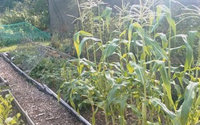DANGEROUS GARDENS
Typical problems reported to charities like the RSPCA include birds crashing into windows, getting feet and beaks trapped and drowning in water butts, baby birds being abandoned because of hedge cutting and hedgehogs being injured when piles of leaves are swept away.
So what can you do to make your garden safer for wildlife?
Window strikes Thousands of birds fly into windows at this time of year with the sun lower in the sky and clumsy late youngsters around. Window strikes are often fatal. They can be prevented with window stickers that have a scarecrow effect. Garden mirrors can be equally hazardous so sticker them as well if you can.
Loose netting Loose fruit netting and mesh bags containing fat balls can easily trap bird’s feet and beaks and other wildlife like snakes could get caught in them too. Pull netting over fruit or ponds taught and remove fat balls from bags.
Hedge cutting Some late nesting birds stay in their nests long into September and hedge cutting and maintenance can disturb the adults so they abandon their chicks. Worse still, power tools can injure the birds or destroy the nest. Hedge cutting is best left until early October.
Leaf and log piles Many hedgehogs sustain horrific injuries when people clear log piles with rakes and power tools. Some have literally been sliced in half and others have lost legs and noses. So, always clear log piles, especially close to hibernation periods, with extra care and avoid using sharp tools.
Drowning Many birds drown in water butts and steep sided ponds at this time of year as they overstretch and fall in. Put a lid on butts if possible and if building a pond try to create gentle slopes so birds can drink easier and mammals like hedgehogs can get out. Putting in a secure sloping plank of wood can help animals get closer to the water and give them an easy, safe exit route.
Feeders Poor quality bird feeders are responsible for hundreds of birds getting trapped and being unable to escape, as well as squirrels. Feet get caught in cheap wire netting round the outside and some birds can even get their heads caught in the hole the food comes out. Make sure you check for any loose bits of wire and choose a feeder made from sturdy materials. Always opt for a feeder with a lid so birds don’t try and access food from the top and get stuck that way.
Slug pellets Some slug pellets can pose a threat to wildlife if used excessively. If birds or hedgehogs eat the slugs and snails that have been tempted by Metaldehyde pellets, this chemical can accumulate inside the unfortunate animal making them very poorly. It is best to use non-toxic control such as beer traps, barriers and hand picking.
These are just a few easy ways in which you can ensure your garden or allotment is a wildlife heaven, not a wildlife hell.
About the Author: Chantal Cooke is a professional journalist, author and co-founder of PASSION for the PLANET

